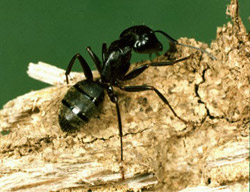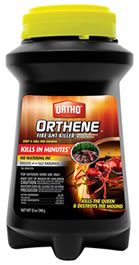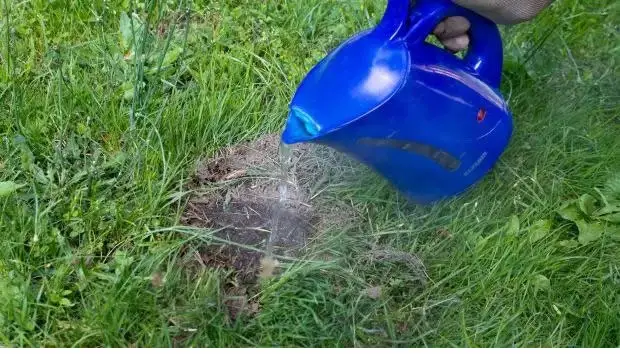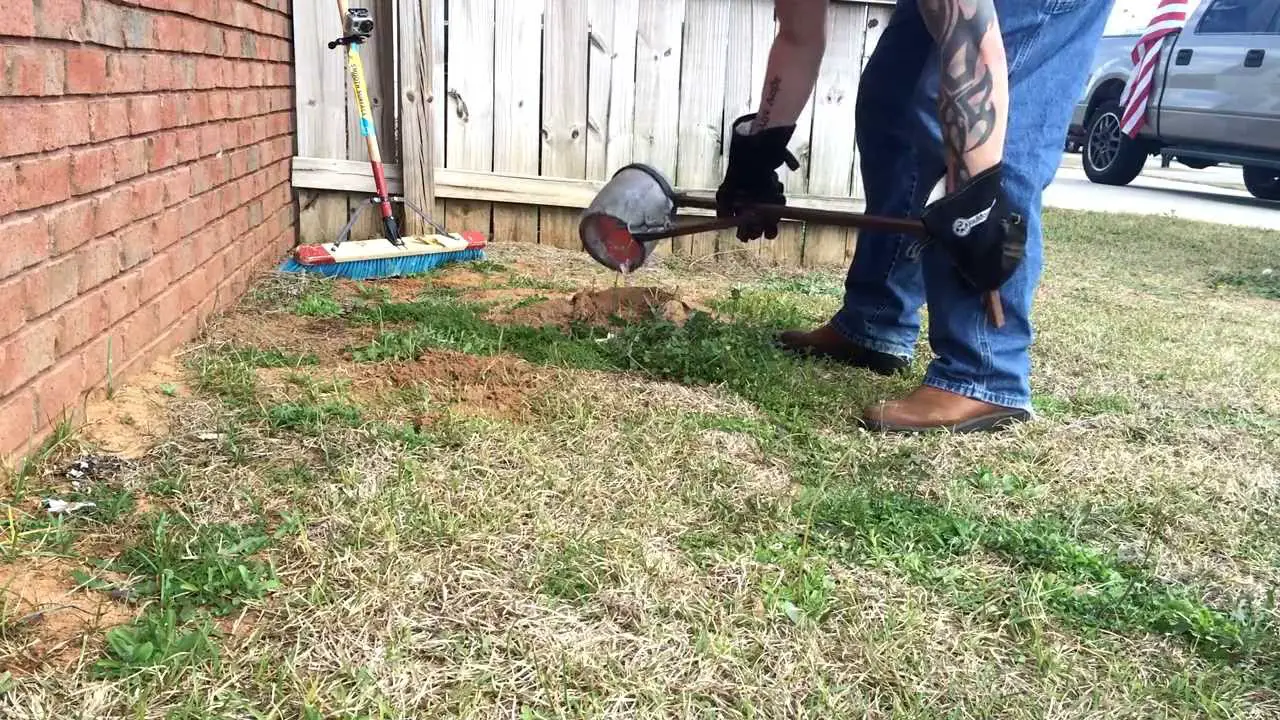There is nothing more annoying to a gardener or lawn lover than discovering an ant colony has taken up residence in a beautifully manicured lawn. For the most part ants themselves pose no real problem to your lawn or plants, other than making the lawn look bad. However, very large nests can disrupt the root systems of plants.
So whether you are worried about the mini-ecosystem in your garden or just want their unsightly presence removed it is important to know how to get rid of ant hills in the lawn in a permanent way without harming your lawn.
Table of Contents
How To Get Rid Of Ants Without Hurting Your Lawn Or Garden
There are several common ways to get rid of ant hills that are messing with your lawn or garden that include both natural remedies and chemical remedies.
Likewise there are several common ways that are promoted that you should definitely not use!

Let’s take a look in more detail at the methods you should not use and the methods that you should use to remove ant hills from your lawn without killing grass.
The approach you use will depend on the extent of your ant problem and how eco-friendly you want your solution to be.
The negative effect ants have on the lawn & garden
Although most ant species are more of a garden nuisance than an actual pest, as most do not directly harm your lawn or plants, they can leave unsightly traces of their activities on your beautiful lawn.
Red fire ants are a pest however and their colony mounds can cause havoc in the lawn as well as causing large red welts to your skin when they attack.
Ants are a natural part of the environment and it is not unusual to see a few wandering across your path.
 However, even when relatively harmless ants set up a nest in your lawn their activities can lead to root damage and unsightly mounds that ruin the look of your yard.
However, even when relatively harmless ants set up a nest in your lawn their activities can lead to root damage and unsightly mounds that ruin the look of your yard.
Ants settle in very large numbers and if there are 2 or more nests you can be sure their tunneling and underground labyrinths are messing with the root system of your lawn or garden.
In addition mowing over the ant hills not only leaves your lawn messy but can damage the blades on your lawn mower.
3 Common Types Of Garden Ants
There are more than 1200 species of ants worldwide.
In North America there are generally several ant species that cause a nuisance in the lawn. Here are a few of them.
Argentine Ants
As the name suggest Argentine ants are native to Argentina.
They were most likely first brought to the USA accidentally in ships in the late 1800’s.
 As these ants thrive in warmer temperatures they are not often found in the very northerly states but are common in southern states.
As these ants thrive in warmer temperatures they are not often found in the very northerly states but are common in southern states.
They are dark brown in color, oval shaped and can range from 1/16” to 1/4“.
Argentine ant hills are generally found near wet environments that are close to a food source.
Argentine colonies can grow to monumental sizes and if not kept in check can literally take over your entire lawn or garden.
Carpenter Ants
 Although Carpenter are usually found in wooden buildings they can also take over your garden.
Although Carpenter are usually found in wooden buildings they can also take over your garden.
They build nests near water and moldy or damp wood, such as tree stumps, firewood or in the plants in your garden.
Although Carpenter ants love damp wood they have been known to adapt to drier environments.
There are several different types of carpenter ants in North America that measure in size from 1/4” to 3/4” and range in color from red to black.
Carpenter ant colonies grow very quickly and can reach populations of 2,000 or more workers.
Red Fire Ants
Red fire ants, also known as RIFA (Red Imported Fire Ants) are not native to the USA.
They are considered a pest.
These ants are the most common ones you will find in your lawn.
 Red fire ants are very aggressive compared to other ant species and tend to sting.
Red fire ants are very aggressive compared to other ant species and tend to sting.
Their sting is painful and can be a health danger if a colony attacks or if a person has an allergy.
Red fire ants build their nests in mounds in your garden and lawn.
Sometimes they will enter buildings but they are mostly found outdoors.
They measure measure in size from 1/8″ to 3/8″ in size are are a dark reddish brown color.
Red fire ants are very adaptable creatures, hence their spread across the US.
They can adapt to different climates and different conditions fairly easily.
Not only do they build mounds that are unsightly but they also feed on vegetation in your garden destroying plants.
6 Effective Methods To Get Rid Of Ant Hills Without Killing Grass Or Plants
Now that you know which methods of ant control you should not use lets take a look at the methods that will solve your ant hill problem.
Although there are various different ways of eliminating ant mounds from your lawn they basically fall into only two categories:
- Natural Methods
- Chemical Methods
The approach you use will depend on the extent of your ant problem and how eco-friendly you want your solution to be.
3 Natural ways to get rid of ants that are eco-friendly
Treating any ant hill in your garden or lawn area can be a concern if you have animals and small children who frequent the area.
For these reasons many homeowners prefer to use natural remedies to tackle the ants rather than relying on a chemical solution.
Here are a few natural remedies that work very well.
Just be aware that if you have an acute ant problem, where there is a very large colony, multiple mounds or the ants are growing rapidly in number, then you may need to resort to a chemical solution.
1. Soapy Water
An effective natural remedy to combat ant hills is to pour down the ant hill a solution of soapy water.
Mix about 3% of dish soap/liquid into warm (not boiling) water and pour it down the ant hill.
You can also put some of the solution into a spray bottle and spray around the infected area.
Spraying soapy water also kills other pests without harming plants.
2. Borax Solution
Borax is a cheap ingredient that can also be mixed with water to create an ant killing solution.
Use it in the same way you would use the soapy water solution mentioned above; mix 3% borax with warm water and then pour down the ant hill.
You can also use the borax solution as a spray.
You can get Borax very cheap online like this stuff on Amazon or it is usually from your nearest shopping mall.
3. Sugar Solution
A sugar solution can also be used.
Simply mix a small amount of sugar with water and use in the same way as the above two methods.
3 Effective chemical methods to get rid of ants
Although using chemicals on your lawn may raise the eyebrows of eco-friendly warriors when you have an infestation of ants and more than one ant hill this is by far the best solution.
Chemical methods for getting rid of ant hills usually start to work within just a few minutes and it rarely takes longer than a few days to totally eliminate a colony.
1. Orthene
 This is by far the most effective ant killer on the market in our opinion.
This is by far the most effective ant killer on the market in our opinion.
Orthene, by Ortho, has been designed specifically to kill fire ants though it will kill any ant species.
It starts working within just a few minutes and targets the queen so that even if any ants escape, the colony will have been destroyed so it won’t be rebuilt.
The great thing about this chemical solution is that can be used on lawns and around plants without damaging them.
Features:
- 50% acephate active content.
- Doesn’t require water to work.
- Within 3 days you can expect the queen to be dead and the colony will be completely destroyed.
- Treats up to 80 mounds.
You can get Orthene on Amazon or at most garden centers.
2. Bayer Advanced Dust
Bayer Advanced is a highly effective chemical dust that destroys the entire colony and the queen.
 It comes in the form of a shaker bottle that is used to sprinkle the formula onto the mound without the need for water.
It comes in the form of a shaker bottle that is used to sprinkle the formula onto the mound without the need for water.
Again this solution has been designed to kill fire ants but will work on any species of ant.
It has an active ingredient of 0.5% cyfluthrin.
Features:
- Kills the queen.
- Kills the entire colony.
- Easy-to-use – just sprinkle on with shaker-top applicator.
- Fast-acting with no watering required.
- Teats up to 130 mounds.
You can get Bayer Advanced on Amazon or at most garden centers.
3. Ortho 0259010 Mound Bait
This Ortho product is used as bait rather than treatment.
 The ants believe that the bait is food. The ants actually do all the work.
The ants believe that the bait is food. The ants actually do all the work.
Believing the bait is food the worker ants will carry the active ingredient, Indoxacarb, to the deepest parts of the mound (and hidden mounds) for feeding the entire colony.
Thus the treatment has maximum reach by getting to places you would not be able to with the other treatment types.
Features:
- Fire ants pick up bait in minutes.
- Kills the queen.
- Destroys the colony.
- Deep-reaching formula.
- Fire ants carry it to the deepest parts of the mound.
- Ants carry it to hidden mounds.
You can get Ortho 0259010 Mound Bait on Amazon or at most garden centers.
2 Common Methods To Get Rid Of Ants You Shouldn’t Use!
The following are some common practices used by people who want to get rid of ant hills in their lawn.
 Unfortunately, these methods, although popular, don’t work!
Unfortunately, these methods, although popular, don’t work!
1. Boiling Water
Many websites promote the use of boiling water to eliminate ant colonies but this is a very bad idea.
Apart from being inhuman (you are literally boiling the ants alive) this method is extremely bad for your lawn and the root system of your grass and plants.
Pouring boiling water down an ant hill will damage your lawn. Don’t do it!
2. Salt
Salt is also very often touted as a great way to kill ant colonies.
However, pouring salt down an ant hill opening will have no effect on the ants.
It will kill the roots of the grass and plants however. It will also damage the soil making it difficult to grow anything in that spot when you do eventually get rid of your ant problem.

